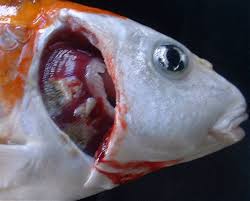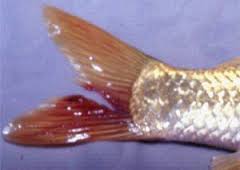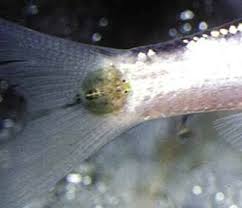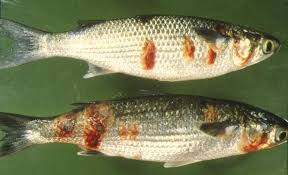Common Fishes Diseases & its Control
A pond ecosystem maintains a good relationship starting with fish to all types of aquatic animals, plants and physic-chemical elements of its surrounding soil and water. If any error occurs in this relationship, then different types of disease may attract the fishes and struck the fish production. Generally, most of the disease occurs in winter season, because at that time water depth of the pond as well as water temperature is low. In winter, their food consumption efficiency and speed of movement in water falls down gradually. Besides, there may be many other reasons due to which fish disease may occur, such as-
- If there is lack of food in the pond.
- When the fish is densely stocked in the pond.
- Misuse of pesticide in pond.
- If pond water is contaminated with the decomposition of wastes and any other dry leaf.
- Excess growth of algae in pond.
- Excess supply of artificial feed to pond.
- Decomposition of organic matter and if aquatic plants at pond bottom is not proper.
Branchiomycosis (gill rot):
Symptoms: Fungus grows out through gill blood vessels and cause death of surrounding tissues, yellow discolouration and disintegration of gill tissue.Control:
- Addition of quick lime @ 50-100 kg/ha to affected pond. (or)
- In case of limited infection, use 3-5% NaCl bath for 5-10 minutes or 5 ppm (5 mg per 1 liter of water) KMnO4 bath for 5-10 minutes. (or)
- Reduce organic load and maintain hygienic condition.

Fin & Tail Rot:
Symptoms: Erosion and disintegration of fin and tails. As the lesion develops the outer fin margin becomes frayed and disintegration of soft tissues between fin rays startsControl:
- Give dip treatment to the infected fish with copper sulphate (CuSO4) for 1-2 minutes at a concentration of 2 mg/ lit. This may be followed by feeding tetracycline to the infected fish along with feed at a concentration of 10-15 mg/ kg body weight of fish. (or)
- Dip treatment with 500 ppm KMnO4. (or)
- Improve water quality and Reduce organic load.

Dropsy:
Symptoms: Accumulation of body fluid/ water in the body cavity or in scale pockets, scales become loose, abdomen bulge largely and pressing on it water comes out through the mouth etc.Control:
- Disinfect affected ponds with 1 ppm KMnO4. (or)
- Dip treatment with 5 ppm KMnO4 for two minutes.

Saprolegniosis (Cotton Wool Disease):
Symptoms: Infected fish shows whitish fungal mesh which looks like cotton wools appears in the infected parts of fish body. Sometimes lesions appear as gray white patches on various parts of the body like- skin, fins, eyes, mouth, and gill.Control:
- Give bath treatment to the infected fish with KMnO4 (Potash) at the conc. of 1 gm/ 100lit. of water for 1 hr. or give bath treatment to the infected fish with the conc. of 10 gm/ lit. of water for 20-30 minutes. (or)
- Give bath treatment to the infected fish with Copper sulphate (CuSO4) at the conc. of 5 gm/ 10 lit. of water for 15-20 minutes. (or)
- Maintain water quality and stocking density.

Argulosis (Carp lice):
Symptoms: Infected fish shows- erratic swimming behaviour & reluctant to accept feed. Parasite is visible with naked eye and ulceration is seen at the attachment site.Control:
- I. Apply potash (KMnO4) to the infected fish pond at the rate of 4 mg/lit. of water (or)
- Give short bath treatment to the infected fish in common salt (NaCl) solution at a concentration of 2.5-3% for 5 –10 minutes. Treated fish should be released to the pond immediately after the treatment. (or)
- Apply cleaner solution to the infected fish pond at the rate of 50- 100ml/ bigha water spread area. If draining is possible then lime at the rate of 200- 250 kg/ ha area can be applied to the drained pond bottom and the allowed to dry for 2 weeks to eradicate the parasites completely. After eradication of the parasite restocking is in the pond is done.

Epizootic Ulcerative Syndrome (EUS):
Symptoms: Tiny red spot on the body surface initially. This spot later develop ulcer. After few days loosing its scales and muscles exposes body. Infected fish dies within a short period.Control:
- Apply lime at the rate of 10- 15 kg/bigha of water spread area depending on PH of water. After 1- 2 days of application of lime to the pond water spraying of “Sukrena W.S.” over the pond water surface at the rate of 500ml/ bigha water spread area. Repeat the application of Sukrena W.S. to the infected pond for 2nd or 3rd times depending on the need basis at 10 –15 days interval. (or)
- Dip the infected fish at 3- 4% common salt (NaCl) solution and released the treated fish immediately to the pond water. (or)
- Apply common salt (NaCl) to the pond water at the rate of 10- 12 kg/ bigha water spread area. (or)
- Apply lime at the rate of 10- 15 kg/bigha of water spread area depending on PH of water. This is followed by application of KMnO4 (Potash) to the pond water at the rate of 4-5 ppm (4- 5 mg/lit. of water). (or)
- Give bath treatment to the infected fish at 4- 6 ppm (4- 6 mg/lit. of water) potash (KMnO4) solution for a short period and then released the treated fish immediately to the pond water.

N.B.: Apart from the any of the above treatment measures antibiotic Oxytetracycline treatment may be given along with any one of the above cited treatment measures. Oxytetracycline are fed to the infected fish along with feed at the rate of 60- 70 mg/ kg feed for 7- 10 days on need basis.
General prevention measure for fish farmers:
- Maintain environmental parameters within limits.
- Provide nutritionally balanced feed.
- Avoid overcrowding.
- Stock disease free fry/fingerling.
- Apply lime at regular intervals.
- Disinfect farm appliances regularly.
- Use chemicals/drugs as per the experts’ advice.